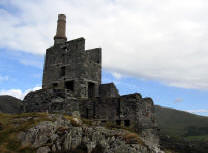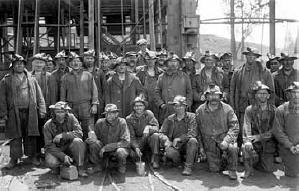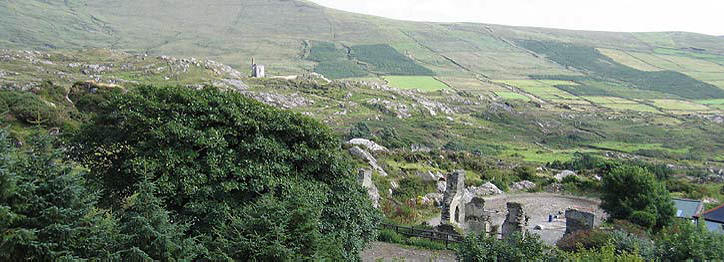|


|
WITH THE SUPPORT OF THE
BRITISH ACADEMY
Networks of Metalliferous Mining Migration in the
Nineteenth Century Transatlantic World: the Cornish and Irish – a
Comparative Study
This British Academy funded comparative migration
project is being undertaken by Dr Sharron P. Schwartz of the University of
Exeter and Professor Graham Davis of Bath Spa University, with the
assistance of Diane Hodnett, Limerick
Ireland.
Migration has been an important feature of European history for centuries.
However, we still know relatively little in detail about migration in the
past. Baines (1994) considered that one of the key questions that needed
to be addressed was the relative incidence of migration in the past: why
did people migrate from some communities and not others? Observers of
contemporary migration such as Faist (2000) have also isolated the
relative incidence of migration as one of the factors problematizing
international migration analyses: ‘Why are there so few migrants from so
many places and so many from only a few places?’
Yet,
there are still few investigations that examine the details of past
migrations from the British Isles, who the migrants were, the type of
communities they came from and what kinship and recruitment networks
supported their migration decisions. In order to address these concerns,
migration research needs to move away from a purely qualitative approach
to encompass quantitative analyses. However, quantitative research that
enables partial life-course reconstitution or longitudinal analyses has
been impossible until relatively recently with access to large
computerised databases of nineteenth century census returns and other
rites of life data available online.
 The
Cornish and the Irish were among the most mobile of ethnic groups in
nineteenth century western Europe and some of this movement was accounted
for by the migration of hard rock miners. Cornwall is renowned for its
mining migration, which has been well documented by Rowe, Schwartz and
Payton (1974; 2000; 2005), but as Cowman has pointed out,
school geography text books of
a generation ago ‘assured us that there had been no mining in Ireland’
(1983). It is no surprise then that the
migration of miners from
Ireland has received rather less attention.
The significance
of emigration streams of Irish miners to metalliferous mining centres in
Britain and the US has been overlooked in mainstream literature that has
focused largely on Irish immigration to the urban centres (Burchall 1979;
Belchem 1990; Davis 1991), exceptions are
Emmons (1989) whose work
focussed on the Irish in Butte Montana;
MacRaild
(1998) who looked at the Irish in Cumbria and
Mulligan (2001) who has analysed Irish migration to Michigan. The
Cornish and the Irish were among the most mobile of ethnic groups in
nineteenth century western Europe and some of this movement was accounted
for by the migration of hard rock miners. Cornwall is renowned for its
mining migration, which has been well documented by Rowe, Schwartz and
Payton (1974; 2000; 2005), but as Cowman has pointed out,
school geography text books of
a generation ago ‘assured us that there had been no mining in Ireland’
(1983). It is no surprise then that the
migration of miners from
Ireland has received rather less attention.
The significance
of emigration streams of Irish miners to metalliferous mining centres in
Britain and the US has been overlooked in mainstream literature that has
focused largely on Irish immigration to the urban centres (Burchall 1979;
Belchem 1990; Davis 1991), exceptions are
Emmons (1989) whose work
focussed on the Irish in Butte Montana;
MacRaild
(1998) who looked at the Irish in Cumbria and
Mulligan (2001) who has analysed Irish migration to Michigan.
 Additionally,
the dominant
discourse of post-famine Irish migration to Britain and the US is that of
destitute, unskilled, often diseased people with few prospects of social
and economic advancement, a movement of non- or semi-skilled opportunists
(see for example Hickey 1967). Yet Ireland was an important centre of
nineteenth century hard rock mining as field and archival research by the
Mining Heritage Trust of Ireland has demonstrated. Additionally,
the dominant
discourse of post-famine Irish migration to Britain and the US is that of
destitute, unskilled, often diseased people with few prospects of social
and economic advancement, a movement of non- or semi-skilled opportunists
(see for example Hickey 1967). Yet Ireland was an important centre of
nineteenth century hard rock mining as field and archival research by the
Mining Heritage Trust of Ireland has demonstrated.
One
of the factors problematizing
the study of Irish migration networks is the absence of census data. In
its place, the Griffith Valuation and other records are used to attempt to
determine where people came from in Ireland using the origin and
ramification of family names as a means to determine geographical patterns
that point to places of origin for certain surnames. For example, people
with names such as Harrington and Sullivan are likely to come from County
Cork, whereas the surnames O’Donnell, Boyle and
McGehan are common in West Donegal (for more on this see MacLysaght,
1985). Current work on Cornish
and Irish migration within Britain and the US has focussed on surname
distribution (for example see Lloyd, Webber and Longley, CASA, UCL and the
ESRC—funded Application of Isonymic Analysis to Historical Data: Irish
Migration to Britain, 1851-1901, Smith, MacRaild et al), but
while this highlights the spatial distribution over time of surnames that
are relatively unique to both Cornwall and Ireland, such a macro-approach
does not sufficiently explore the dynamics of migration networks: how did
they come into being, why were they localised and how were they sustained
across time and space leading to often distinct settlement patterns?
Moreover, as Kenny argues in his 1998 work on Irish immigration to the
anthracite region of Pennsylvania, 'surname analysis, on its own, cannot
produce scientifically reliable data and is only of use if it supplements
a pattern verified elsewhere'.
Our project is innovative for three reasons:
-
there has been no comparative research of Cornish and Irish hard rock
mining migration and our research will break new ground in exploring
similarities and differences in migration networks and settlement
patterns in our case study areas.
-
it
will link internal and external migration flows, for migration within
the boundaries of the nation-state and emigration outside those
boundaries have usually been treated separately and comparisons across
international borders and internal migrations are therefore rare.
-
it
attempts to move beyond previous research on surname recognition. This
has identified certain patterns of skill migration from Cornwall/Ireland
within Britain and to centres in the USA. With a micro-study of specific
names and families, a fine mesh analysis of the networks and process of
migration could be reconstructed, an approach called for by Baines back
in 1994. The principal working hypothesis is that many of the migration
streams from Cornwall and Ireland were skill-based and localised.
Project Methodology
For the purposes of our pilot study we have decided to employ four case
studies that span the nineteenth century and take in four important hard
rock mining areas in Britain, Ireland and the US. We will extract a cohort
of Irish and Cornish miners from each of the following records to which we
have full access: 1) the 1870 Census for Keweenaw, Michigan; 2) the 1881
Census for Cumbria; 3) the 1861 Census for Cornwall; and 4) the Allihies
Mine Cost Books (West Cork) Jul 1833-Dec 1837 and Jan 1838-June 1844 used
in tandem with the Griffith Valuation, the Tithe Apportionments and all
other available records. We estimate this will give us approximately 1,200 Irish and Cornish miners.
Utilising methods employed by genealogists, we will then nominally link
our cohort individuals both backwards and forwards using computer-assisted
manual linkage methods using the nineteenth century census returns to
which we have full access, civil registration data (for example,
Ancestry.com and FreeBMD available online), company work records, and
other data based records to explore similarities and contrasts in the
timing, direction and longevity of migration networks from Ireland and
Cornwall. This research project will thus bring together the genealogical
approach with that of the academic resulting in a more holistic study of
the dynamics of the migration process.
We
are only testing the feasibility of a quantitative approach in this pilot
project and we would emphasis that relationships between mobility and
other variables that are indicated by quantitative data will need to be
supplemented by qualitative data that provide more evidence for the reason
for the migration flows rather than their context. This will be addressed
in a future, more elaborate joint project. |


 The
Cornish and the Irish were among the most mobile of ethnic groups in
nineteenth century western Europe and some of this movement was accounted
for by the migration of hard rock miners. Cornwall is renowned for its
mining migration, which has been well documented by Rowe, Schwartz and
Payton (1974; 2000; 2005), but as Cowman has pointed out,
The
Cornish and the Irish were among the most mobile of ethnic groups in
nineteenth century western Europe and some of this movement was accounted
for by the migration of hard rock miners. Cornwall is renowned for its
mining migration, which has been well documented by Rowe, Schwartz and
Payton (1974; 2000; 2005), but as Cowman has pointed out,  Additionally,
t
Additionally,
t